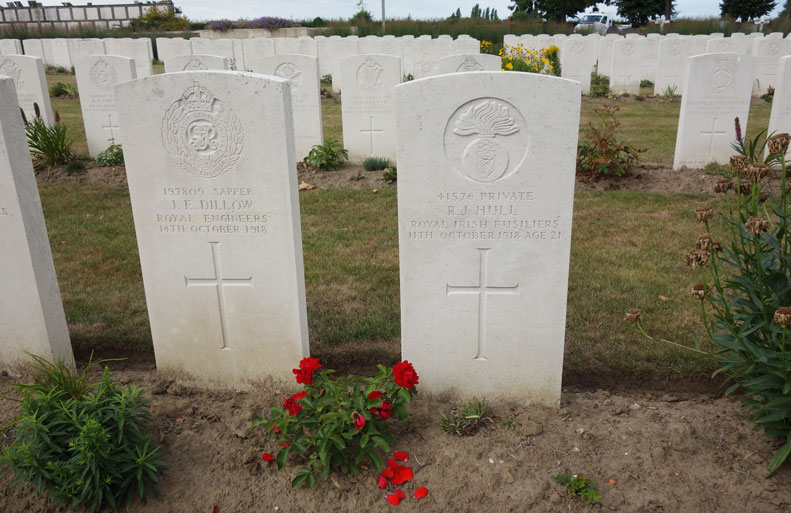![]() In memoriam
In memoriam ![]()
Private Robert John Hull
Robert John Hull was born on 23 January 1896 at Lambeg, County Antrim, the eighth of nine children of labourer and carter George Henry Hull and his wife Harriet (nee Lavery). By 1911 he was living with his parents and three of his four surviving siblings at Wesley, Lisburn, County Antrim, and was employed as a mill worker.
Hull enlisted in the North Irish Horse at Antrim on 8 May 1915 (No.1519). He gave his occupation as engine driver. He was promoted to lance corporal on 28 December 1915 and embarked for France with E Squadron on 11 January 1916.
On 11 May Hull was seriously injured. According to E Squadron's commanding officer Captain Finlay:
L/Cpl Hull R. was grazing two Horses on the Road Side in the village of Grouches when one of the Horses bolted at the same time kicking L/Cpl Hull on the Head. I do not consider the soldier was in any way to blame.
Hull was unconscious for at least a week, suffering from a depressed skull fracture. He was evacuated to No.10 General Hospital at Rouen and then to England, where he spent two months at the Beaufort War Hospital at Bristol. Fortunately he fully recovered, and after ten days furlough at home reported for duty at the North Irish Horse reserve depot at Antrim. He was promoted to corporal on 1 August 1916.
Hull embarked for France on 20 September 1916, where he was posted to either C or B (formerly F) Squadron of the North Irish Horse. In November he reverted to the rank of private at his own request. He spent twelve days in hospital in March 1917 suffering from 'pyrexia of unknown origin' – probably trench fever.
In June 1916 B and C Squadrons had come together with the 6th (Inniskilling) Dragoons Service Squadron to form the 2nd North Irish Horse Regiment, serving as corps cavalry to X Corps. In August 1917 orders came that the regiment would be dismounted and its men transferred to the infantry. Hull was one of 70 men given the job of conducting the regiment's horses to Egypt. They embarked from Marseilles on board HMT Bohemian on 25 August. After a month at Alexandria they returned to France, via Italy. On 5 October 1917 they arrived at the 36th (Ulster) Division Infantry Base Depot at Harfleur for infantry training. After just a few days they were posted to the 9th (Service) Battalion, Royal Irish Fusiliers – renamed the 9th (North Irish Horse) Battalion – joining it in the field at Ruyaulcourt on 12 October. Hull was issued regimental number 41576 and posted to D Company.
Hull probably saw action with the battalion at the Battle of Cambrai in November and December 1917. He was allowed a fortnight's leave from 25 December.
Following the retreat from St Quentin from 21 to 28 March 1918 during the German spring offensive, Hull was initially posted as missing. Soon after, however, he rejoined the battalion. His father, having received notice of the first report from the army, wrote back on 10 May:
In reply to your letter that I received stating that my son 41576 Pte Robert John Hull Royal Irish Fusiliers was posted as missing on 21-29 March 1918 I am very pleased to say that I have received three letters from him since that date and I am forwarding this letter as it is the last one I got from him.
On 30 September 1918 the 9th (NIH) Battalion was ordered to advance on the Belgian village of Vijfwegen. The fighting centred on a small rise, Hill 41, which had been well fortified by the Germans and afforded a wide field of fire on troops attempting to move past it. During this and the following day they sustained numerous casualties but were unable to capture the hill. From 7 to 9 October preparations were made for another attempt on the hill. According to the battalion war diary:
At dawn [on the 11th] a party of thirty O.Rs under 2/Lieut Darling MC formed up in Twig Farm. At 10.00 under cover of a barrage and smoke screen, they rushed Goldflake Fm, capturing 14 prisoners, 3 M.G & killing about 10 of the enemy. A position about 100 yards S.W of the farm was consolidated. The hostile barrage was extremely heavy … Our casualties were 1 killed & 2 wounded.
The enemy was not done, however, and just before 6.00pm an intense artillery barrage preceded a powerful counter-attack on Goldflake, Mansard and Twigg Farms.
The garrison in Goldflake Fm withdrew after inflicting very heavy casualties on the enemy who were caught in fours on the road. The garrison of Mansard Fm was surrounded & fought their way back. The enemy succeeded in reaching Twig Fm but was held up by a small party which still held out in front of the farm. The enemy was finally cleared from Twig Fm by a counter attack. Mansard & Goldflake Fms remained in his hands … Our casualties during the day were 2 officers & 25 O.Rs.
Private Hull was one of the men killed that day. He was was buried near where he fell in front of Twigg Farm, Hill 41, Belgium (map reference 28.L.19.a.0.4), the location marked with a cross. After the war his body was exhumed and re-buried in the Dadizeele New British Cemetery, Moorslede, West-Vlaanderen, Belgium, grave I.D.10. His gravestone inscription reads:
41576 PRIVATE
R. J. HULL
ROYAL IRISH FUSILIERS
11TH OCTOBER 1918 AGE 21
Private Hull's older brother George Henry also served during the war, with the 11th Battalion Royal Irish Rifles and 108 Company of the Machine Gun Corps. He was killed in action on the Somme on 1 July 1916.

Images Copyright © Phillip Tardif with all rights reserved as set out in this Use of Material policy.

